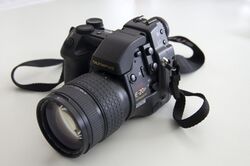Engineering:Olympus E-20
From HandWiki
Short description: Digital camera model
 | |
| Overview | |
|---|---|
| Type | Non-interchangeable lens DSLR |
| Lens | |
| Lens | Non-interchangeable |
| Sensor/medium | |
| Maximum resolution | 2,560 × 1,920 (5.2 million) |
| Film speed | 80 to 320 |
| Storage media | SmartMedia, CompactFlash (Type I or Type II) |
| Focusing | |
| Focus modes | Auto, Manual, Auto+Manual, Continuous |
| Exposure/metering | |
| Exposure modes | Manual, Shutter Priority, Aperture Priority, Program |
| Exposure metering | ESP, center-weighted, spot |
| Metering modes | ESP, Center-Weighted, Spot |
| Flash | |
| Flash | both built-in and hot shoe |
| Shutter | |
| Shutter speed range | 1/640 to 60 seconds, bulb |
| Continuous shooting | 2.5 frame/s (4 images) |
| Viewfinder | |
| Viewfinder | Optical TTL |
| Image processing | |
| WB bracketing | Yes, adjustable to increments of 2 steps, 3 steps, or 6 steps. |
| General | |
| LCD screen | 1.8" flip-up (118,000 pixels) |
| Battery | (4) AA NiMH batteries and charger (supplied) |
| Weight | 1190 g (42 oz) |
The Olympus E-20 (available under the names E-20N and E-20P, depending on whether it had NTSC or PAL video output, respectively) is a 5-megapixel non-interchangeable lens DSLR manufactured by Olympus Corporation of Japan, as a successor to its E-10 model. It also has a fixed lens and a beam splitting prism instead of a moving mirror. It has easy dial keys for choices of pictures, videos, and more. It was announced on September 13, 2001.[1]
See also
References
External links
Official sites
Product reviews
 |

